Quality Silage Preservation with ActiProp Tech
By Dr. Mahesh GR, Technical Team, Trouw Nutrition South Asia
Introduction
Green fodder is considered as an economical source of highly digestible nutrients, but its availability throughout the year is an issue. Green fodder can be preserved in the form of silage to ensure a regular supply of green fodder throughout the year. Fodder crop rich in soluble carbohydrates like maize, wheat, sorghum, oats, and hybrid Napier are incubated after chaffing for 30-40 days under anaerobic conditions. Silage is the preserved green fodder having moisture in the range of 65%-70% with easily fermentable carbohydrate source of energy for dairy cows. Good silage preparation methods probably result in total dry matter losses of less than 5 to 10%. Whereas poor methods coupled with poor storage conditions may result in total dry matter losses greater than 10%. Poor fermentation can lead to excessive runoff, loss of nutrients, and production of spoiled silage that is no longer fit for feeding. Good quality silage is golden brown to greenish yellow in colour, with no butyric acid (less than 0.2%) or ammonia odour. Preparation of quality silage needs limited plant respiration, less aerobic microbial growth, acidic pH, and less scope for regrowth of harmful microbes
Silage Preparation
2.1. Preparation
The crops rich in fermentable sources of carbohydrates like maize, wheat, oats, sorghum, mixed grass, and Napier are best suited for silage production. Crops must be harvested at 25-35% dry matter, the milk line in maize kernel is a common visual tool to estimate kernel moisture (fig 1). Generally, when the milk line is 1/2 to 2/3 down from the kernel crown, the total plant moisture content is between 60 to 70% but a more accurate tool for measuring moisture content is a microwave oven. To make good quality silage the rapid removal of air, the rapid production of lactic acid that results in a rapid drop in pH, and the continued exclusion of air from the silage mass during storage are necessary. A rapid removal of air prevents the growth of unwanted soil contaminants like clostridium, harmful aerobic bacteria, yeasts, and moulds.
Silage preparation process:

Silage fermentation process
The silage fermentation process takes place in 4 phases (fig 2)
Phase one (aerobic phase may last for 5-24 hr) starts immediately after chopping, plant respiration continues for some hours even after chopping and it lasts until the anaerobic condition sets. Phase one decreases the nutritional value of the forage, therefore establishment and maintenance of anaerobic conditions in the ensiling structure at the earliest possible time are essential to maximising the nutritional value of the forage. Lactic and acetic acids are more desirable acids in silage while levels of butyric acid are mainly produced due to clostridial fermentation and should be as low as possible. High temperatures and prolonged heating are commonly observed in the silage if the air is not removed quickly. Improper silage preservation leads to growth of butyric acid bacteria which will spoil the silage quality making it unsuitable for feeding to animals. Fine chopping (<2cm) and compaction of fodder particles to reduce trapped air in between reduce the duration of this phase.
In phase two (initial anaerobic fermentation may last for 1 to 3 days) acetic acid-producing bacteria ferment non-structural carbohydrates to acetic acid. In addition to being an energy source for the ruminant’s acetic acid improves the proliferation of lactic acid bacteria in silage and reduces the pH approximately to 5.0. Reduced pH will further inhibit the acetic acid-producing microorganisms.
Phase three (actual anaerobic fermentation may last for 3-6 days) is characterized by the growth of lactic acid producing bacteria fermenting non-structural carbohydrates to lactic acid responsible for increasing the acidity and decreasing the silage pH. A rapid decrease in pH will impairs the growth of undesirable anaerobic microorganisms such as enterobacteria and clostridia.
Phase four (Storage phase may last for 7-21 days) is the period in which silage pH drops below 4 which prevents the spoilage by reducing the growth of harmful microbes. Though storage phase is completed by 21 Days but for improved palatability and digestibility of preserved fodder, it should be open only after 30-45 days. After opening the ensiled forage, it gets exposed to oxygen and oxygen initiates secondary aerobic degradation of the forage by microorganisms and will facilitate the growth of yeast and fungi (fig 3).
Fig : 1 Showing corn maturity for ensiling
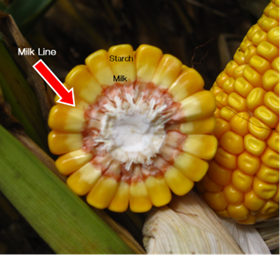
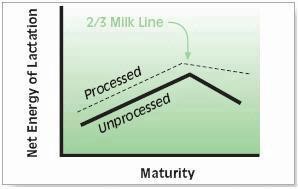
Fig : 2 Silage Fermentation Process
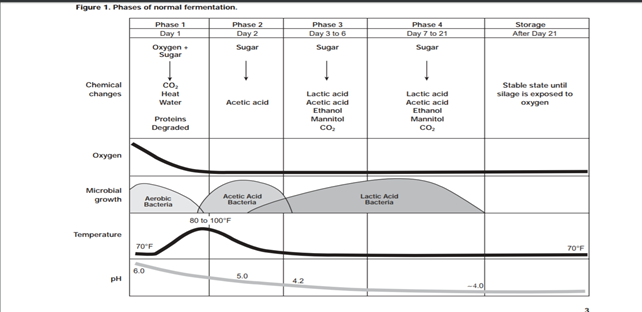
|
Ref: PSU, USA |
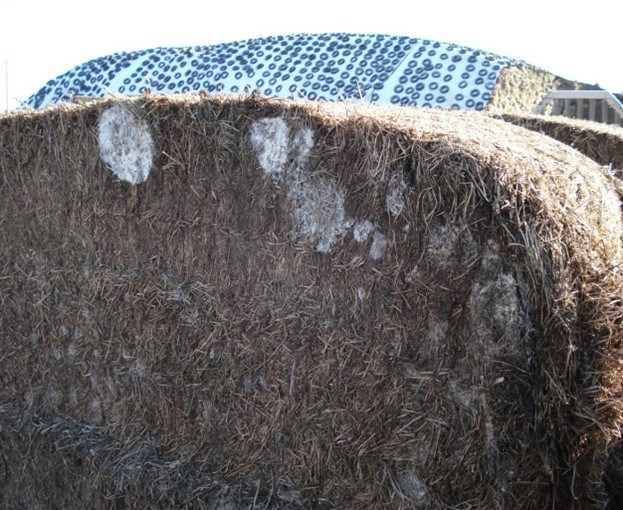
Fig 3: Spoiled silage with yeast and moulds
2.3. Silage Quality
High-quality silage must have minimal fermentation losses and provide nutrients and energy to the animals. One can access the quality of silage by analysing the fermentation (Table-1) and nutritional parameters (Table-2). Another method is by Flieg index (Table-3) which can be used to measure the fermentation quality of silage by taking the pH and dry matter (DM) content of the silage.

Table-1: Fermentation quality parameters

Table-2: Nutritional quality parameters
Table-3: Flieg Index Score (Flieg index: 200+ [(2*DM-15)]-40*pH)
|
Flieg index |
Interpretation |
|
<20 |
Very low quality |
|
21-40 |
low quality |
|
41-60 |
Medium quality |
|
61-80 |
Good quality |
|
81-100 |
Very Good quality |
(Killic, 1986)
Aerobic instability of silage after opening can be a major issue, elevated silage temperature is a good indicator of aerobic spoilage and silage will often heat up after 3 to 5 days’ exposure to air which may cause 10-15% loss of silage DM present at the time of opening. Yeasts and moulds are the primary microorganisms that cause aerobic spoilage and heating. In silage when opened to air, yeast growth rises and metabolizes lactic acid which causes the pH of the silage to increase, thus allowing bacteria that were inhibited by low pH to grow and further spoil the mass. Spoiled silage with mycotoxins will create huge losses to dairy animals by reducing productivity and immunity. Organic acids like propionic acid, acetic acid, sorbic acid, lactic acid and formic acids are extensively used to prevent silage spoilage by yeasts and moulds.
3. Fylax Flow Acti prop technology
Organic acids like propionic acid, acetic acid, sorbic acid, lactic acid, and formic acids either singly or in combinations have been used extensively in silage preparations. Organic acids act by direct silage acidification associated with a rapid decrease of pH, and inhibition of harmful bacteria (Cazzato et al., 2011). Propionic acid has been used to improve silage aerobic stability by inhibiting the growth of mould and yeast by staying active on the surface of microorganisms and competing with amino acids for space on active sites of enzymes or through altering the cell permeability of organisms (Queiroz et al., 2013). Adding propionic acid-based organic acid to whole-plant corn silage improved several parameters associated with nutrient losses, aerobic stability, fermentation profile, and chemical composition (Gheller et al., 2021). Woolford and Cook (1977) reported that incorporation of propionic acid at 12.5 g/kg prevented DM losses in high DM silage (340 g/kg DM) for 19days after air exposure. Organic acids have corrosive, pungent and offensive odour and can cause burns to the handler. Keeping in view of the above problems Trouw Nutrition has come up with the novel patented product called Fylax Forte with an ActiProp technology (Fig 4) involving a unique and synergistic combination of buffered organic acid as well as surfactants. Synergistic blend of buffered organic acids gives powerful inhibition instead of arresting the growth of yeasts, moulds, and harmful bacteria in addition to minimizing evaporation and ensure a long-lasting protective effect in ensiled material. Surfactants in Fylax Flow and Fylax Forte optimize the distribution of organic acids throughout the silage and control the free water (a) activity in silage.
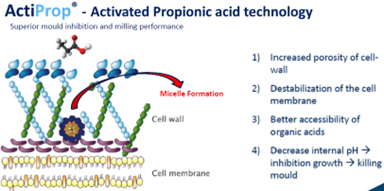
Fig-4: Activated propionic acid technology
Conclusion
Silage is an excellent source of fodder for high producing ruminants. The harvesting crop should have correct DM content and fermentable sugars for ensiling. Careful management at the time of filling and emptying the silo can reduce the risks of aerobic spoilage and heating of silage. Additives like organic acids have been used to limit aerobic spoilage in the silo. Organic acids promote a rapid decrease in silage pH and improve silage fermentation quality thereby reducing the nutrient losses and retaining the nutritive value of the ensiled material. Organic acids are better suited to India as it remains stable even in hot and humid conditions which is not possible with the inoculants. Keeping in view of the corrosive action of organic acids. Trouw nutrition developed a novel patented product Fylax Forte with ActiProp technology containing buffered organic acids and surfactants which helps in effective moulds and yeast control without causing any harm to the handlers.
For further information, kindly write to us at customercareindia@trouwnutrition.com or visit our website: www.trouwnutrition.in